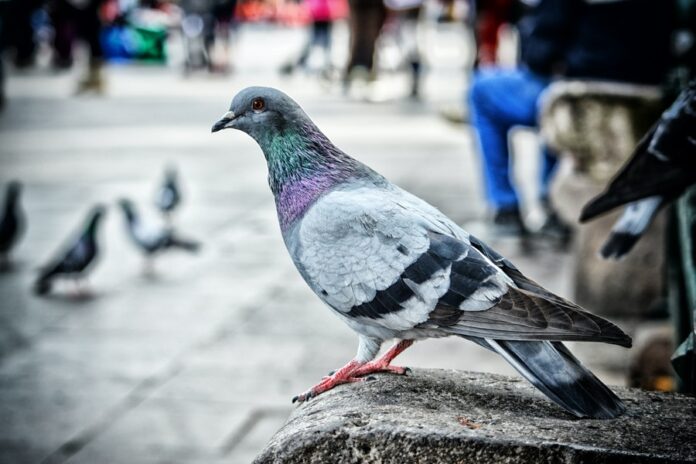A pigeon infestation is a frustrating challenge for home and building owners. Pigeons settle in, build nests, and continue reproducing if left unchecked. Since most people want to deal with the problem humanely, pest experts have spent years developing mechanisms and products that prevent pigeons from nesting in areas where they are placed.
Building owners also take precautions, such as ensuring that they cut off any pigeon food sources and destroy pigeon nests. However, it seems that a multi-disciplinary approach is best suited to eradicating a pigeon problem.
Spikes, wires, nets, and slides
There are a lot of tactics to get rid of pigeons that can be effective. Stainless steel springs or spikes are installed in the affected area. Then wires are strung tautly between the spikes. Alternatively, buyers can opt for a spike strip that fits onto a wall, with the pointed spikes so close together that pigeons cannot fit between them. The spikes with wire spanned between them also work well because pigeons will not nest in a location they cannot access with ease.
Pigeon-resistant netting is typically made from UV-stabilized polyethylene that is resistant to persistent pigeons and the elements. It is placed across areas where pigeons have been known to nest so that their access to those areas becomes impossible.
Pigeon slides are sheets of plastic installed on flat surfaces at a 45-degree angle. Pigeons find it impossible to build nests at this angle and will look for somewhere else to create a home.
A long-term solution?
While measures like spikes, wires, nets, and slides will force pigeons to move, they do not solve the pigeon overpopulation problem. You will find it impossible to completely foil pigeons’ attempts to find somewhere on your property to nest. As soon as they find somewhere new, you will have to put measures in place to move them on again.
Even if you get pigeons to stop nesting on your property, they are still in the neighborhood and will visit your garden looking for food. Pigeons use their size and numbers to dominate and chase other birds away from feeders and other food sources. Therefore, while the measures mentioned before might exclude pigeons from nesting at your home, they do not solve pigeon overcrowding.
Abatement strategies
Pigeon abatement strategies involve finding ways to prevent pigeons from breeding. Pigeon populations are currently growing while other common birds, such as doves and sparrows, face declining numbers. There are insufficient food sources to feed all these birds. With pigeons being so dominant, they hog accessible food supplies, leaving other birds with nowhere to feed. Therefore, experts advise dealing with pigeon problems from a reproductive standpoint.
A prime example of a pigeon abatement strategy is pigeon birth control. This substance, fed to the birds through grain and other bird food, allows female pigeons to breed, but their eggs do not hatch. This can reduce a pigeon population in a designated area by 50% within a year. Other than rendering the pigeons’ eggs from not hatching, the birth control substance has no adverse effects on the birds. As pigeons tend to squabble over food and chase other species away, the likelihood of those birds accessing the pigeon birth control is low.
Although laborious and time-consuming, replacing pigeon eggs with dummy eggs is another abatement strategy. However, it means crawling around and digging in pigeons’ nests, which can be dangerous given that these birds carry ticks, fleas, and other parasites. Your efforts will hardly be welcomed by angry pigeon parents who will not take kindly to your interference.
Remaining options
Continual nest destruction is another tactic to prevent pigeons from breeding. However, it presents hazards to those who do this for the reasons mentioned before. Even the dust from a pigeon’s nest may contain harmful substances that cause illness.
Nest destruction and removal is only a temporary solution as pigeons will find somewhere safer to nest and continue breeding. Like spikes, wires, nets, and slides, these techniques only get pigeons to move, and while it may delay their breeding, it undoubtedly will not eliminate it.
Trapping pigeons and relocating them only moves the problem from one place to another. In any case, pigeons have strong homing instincts and will soon find their way back to your property.
More extreme solutions
While it is a sensitive subject that some animal activists do not regard as an option, culling is another method of getting pigeon populations under control. However, this means poisoning or shooting them.
As uncomfortable as the topic may be, culling is an effective population control measure. It is used among other animal species, especially those encroaching on human settlements and posing a danger to people. It may seem cruel but might be a vital turning point in restoring balance to the ecosystem, where pigeons should not dominate other bird species to the extent that they do.








![Avast Driver Updater Key 2022 | Activation Key V2.5.9 [Free]- Avast Driver Updater Key 2021](https://vintank.com/wp-content/uploads/2021/02/Avast-Driver-Updater-Key-2021-100x70.jpg)
![Avast Premier Activation Code and License Key [Working] Avast Premier Activation Code and License Key](https://vintank.com/wp-content/uploads/2021/09/Avast-Premier-Activation-Code-and-License-Key-100x70.jpg)
